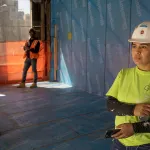As the $1 trillion bipartisan infrastructure bill to update roads, bridges and broadband networks makes its way through the Senate, lawmakers are pushing for additions and amendments, including one that may give women more access to the opportunities and jobs the bill promises to provide.
Sen. Kirsten Gillibrand of New York and eight co-sponsors have proposed an amendment this week that aims to increase opportunities for women and people of color working in the skilled building trades. The amendment sets goals for work hours performed by those underrepresented groups and proposes that 15 percent of work hours for new construction projects under the bill be set aside for apprenticeship programs, which tend to draw more women and people of color
Equity has become a prominent factor in infrastructure discussions this year. “There is racism physically built into some of our highways,” Transportation Secretary Pete Buttigieg said in April, acknowledging a history of racism in infrastructure, including the 1956 National Interstate Highway Act that uprooted 475,000 families, overwhelmingly affecting Black people.
Gillibrand’s amendment acknowledges another inequity built into infrastructure: the people who economically benefit from construction projects. According to the Bureau of Labor Statistics, women only accounted for 10 percent of construction workers in 2018, and 88.6 percent of all people employed in construction in 2020 were White.
“Every crisis presents opportunities, and embedded in the crisis of our nation’s decaying infrastructure is the chance to open up work in the skilled construction trades to people who have historically faced multiple barriers to entrance,” Gillibrand, a Democrat, said.
The prospects for the amendment remain unclear as Gillibrand continues to lobby her colleagues. Senate Majority Leader Chuck Schumer said on Wednesday that he hopes to “bring this bill to a close in the very near future.”
Jobs in construction and other skilled labor can offer a financial lifeline to women, but opportunities are relatively few because personal relationships play such a big role in recruiting and hiring.
Leah Rambo, the training director for the New York City union Sheet Metal Workers Local 28, said the barrier to entry is steep in part because women don’t often hear about construction jobs. She said that tradition drives the industry, which is predominantly made up of men who pass down trades to their sons or nephews.
Rambo, who became a sheet metal worker 33 years ago, said “there would be no women in construction without apprenticeships,” and added that it’s important that apprenticeships be advertised widely and visible on the Department of Labor’s website. This allows women to find training programs without relying on referrals or word of mouth.
The Bureau of Labor Statistics’ press officer, Gary Steinberg, said that apprenticeship programs are too small to gather accurate demographic data on participation or long-term career tracking.
But Rambo said in her experience, there are more women apprentices than women in the construction industry. Even after women complete training programs, she said, men who aren’t used to working with women might hesitate to hire them or keep them on a team.
“When you don’t want someone there, you find a way to get rid of them,” she said.
Lauren Sugerman, the director for the Center for Women’s Employment Equity at Chicago Women in Trades, a nonprofit group advocating for women in skilled trades, contributed to some of the language in Gillibrand’s amendment and said she hoped two of the amendment’s goals — working in tandem — might offer more opportunities to women and people of color in the building trades.
Sugerman said some workplaces argue they don’t have enough women or people of color in their unions to fulfill their diversity goals. Allocating a portion of the work to apprentices allows workplaces to pull from a more diverse pool and enables women to have more access to jobs, she said, which might encourage them to stay.
-
More from The 19th
- Women drove 70% of the job gains in July, the second straight month of strong job growth this year
- Moms spent the equivalent of a full-time job on child care last year — while working at the same time
- These women thought a class-action discrimination lawsuit would help. It didn’t.
Jazz Allen, a skilled tradesperson who completed an apprenticeship with Local 1 Ironworkers, said she hopes the door to the construction trades opens wider for more women.
“It’s the best thing I ever did,” said Allen, who previously worked in custodial services and child care, and struggled to find work because she had been incarcerated. The apprenticeship helped her find better-paying work and establish stability.
“Every day in life, you could start over,” she added.
Rambo said she used to overhear men say that women left the industry because “‘the work is just too hard, too dirty,’ which is nonsense.” She said that women often take on jobs like domestic work and caretaking, which are physically rigorous but pay less on average than construction. According to the Economic Policy Institute, women make up about 91.5 percent of all domestic workers in the United States. According to the Bureau of Labor Statistics’ 2020 data, the average annual income for a housekeeper is $28,010; it’s $51,370 for a sheet metal worker.
The jump in income between construction work and jobs more widely available to women made a significant difference for Lisa Guzman, 46, a third-year carpenter apprentice with Local Union 58 in Chicago. She was a sales manager for 17 years until she was laid off. She didn’t have a college degree and said that other jobs she looked at “paid pennies compared to what I was making before.”
As a single mother, Guzman needed to be financially stable, so she thought about going back to school, but couldn’t justify the debt. Her construction apprenticeship pays throughout the program, increasing income with every year, and provides health insurance after 500 hours of work experience. As a result, the apprenticeship was a financial solution for her family.
“I often tell people, ‘Sometimes you’re still not sure what you want to be when you grow up,” said Guzman. “I’ve never been happier doing a job.”






